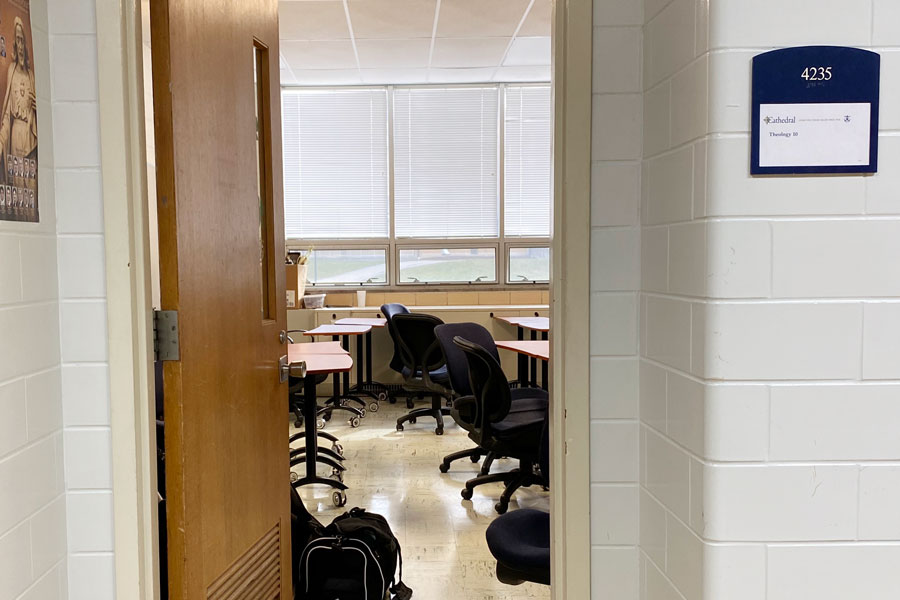Structured flex displays its advantages
‘Flex’ibility creates alternatives to detention
Classrooms such this one in Kelly Hall will have students on Jan. 12.
Having clean shaven faces, showing piercings only in the ears, wearing closed toed shoes and being in proper uniform (including lanyards) keep you from having to serve a structured flex, as well as having good attitudes and following the rules.
But structured flex — sometimes referred to as flex jail — is not detention.
Vice Principal Ms. Kathy Saum was part of the team that decided against detention and created structured flex. “A consequence should follow the wrong action quickly, so it was an issue finding a time for detention outside of sports and the buses,” she said. Issues arose about when students could serve detentions, because sports and bus schedules got in the way of time and detentions were postponed, she said.
The solution was to make a new detention during flex, as this time takes place during school hours and does not interfere with bus schedules or sports. One infraction meant one structured flex, just as detention had worked.
“The only disadvantage is that there is still something to be said about having to serve a detention outside of school,” Saum said. She isn’t against the new system of discipline and is supportive. Saum said, “We have less detentions since structured flex. I think it has helped our students make a change in their behavior, because the punishment is followed through.”
Structured flex supervisor Mr. Ed Freije ‘99 helped explain how structured flex works. “First, a student will come in to me and I’ll give them a paper with the Cathedral Way on it, and they’ll have to write that down five times. This reminds them of the rules. After they finish that, they can work on homework quietly.”
The students who come into structured flex vary, but Freije said he’d guess that most are freshmen and seniors. The structured flex room (4235) rarely gets full, but the room next door is always there in case Freije’s does fill.
“Students come in and serve their time here, and then they continue with their life. It isn’t challenging to write the Cathedral Way down,” Freije said.
So if structured flex isn’t that challenging, what do teachers think about it? Do they find it a rightful punishment, or do they want something more? Students have their views on structured flex, but teachers do as well.
Some punishments, such as wearing the wrong sweatshirts or having facial hair can earn a student structured flex. Unmannerly actions like swearing and yelling can, too. The severity of the punishment can be structured flex, or going to the principal or vice principal. There isn’t an in between punishment, Freije said.
Theology teacher Mrs. Rebecca Heger explained her views. “I think it was a good idea, but there needs to be specific hours for the specific infractions. But really, this is where we are now. And I know everybody has rules; the infractions help the students prepare for the rules in the real world.”
Math teacher Mr. Peter McCarthy also shared his opinion of structured flex. He came to Cathedral this year only a few days before the start of school, and said he was intrigued with the original system the school has used in previous years.
“My honest opinion is that I think the concept is a good one. My understanding is that they take your flex away due to behavioral issues or academic issues. In either case, I think it’s a good strategy because you’re requiring a student to do something that they haven’t shown the personal control to do on their own. I think that’s what makes them better,” said McCarthy.
Both Heger and McCarthy said they believe that the punishment should be picked to specially fit the infraction. McCarthy said, “I think the crime should fit the punishment. Or vice versa, really.”
Structured flex isn’t used to punish students in the eyes of teachers, but instead to reinforce good behavior in the classroom and hallways and eventually in the world.
“I think there’s some value in having the student do something positive during detention. I also think that if a student is in structured flex for academic reasons, then what we’re doing here is good, because it gives them time to focus,” McCarthy said.
Structured flex is a time to reflect on your actions and get schoolwork done, as well as to reinforce the rules of dress code and attitude. Both Heger and McCarthy said they truly believe this is for the good of the students.

Ella Bundy is a junior and a reporter for the Megaphone. At Cathedral she is the student leader of the Alliance club and outside of Cathedral she spends...







